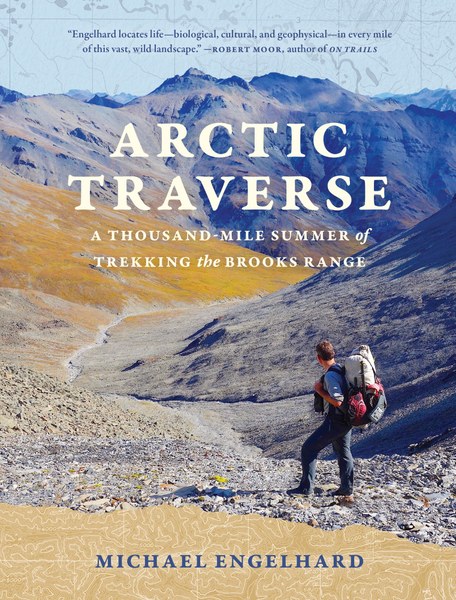Sure, you’ve read about hikes along the Appalachian Trail or the Pacific Crest Trail, but what about the Brooks Range? These mountains, which are more than 125 million years old, span about 700 miles (1,100 km) across northern Alaska into the Yukon Territory in Canada. While not exactly the first place you think of to take an epic hiking trip, that’s exactly what Michael Engelhard did.

Engelhard is no stranger to these Alaskan mountains; he first encountered them in 1990 as an anthropology grad student, and in Arctic Traverse: A Thousand-Mile Summer of Trekking in the Brooks Range, he sets off not only on an exploration of the range but on a journey with himself as well. He writes, “I want this 700-mile-long, 150-mile-wide upthrust not fully mapped until forty-four years after Alaska’s purchase, the world’s northernmost major range and largest official wilderness, to be my jagged Sand County, my bottomless Walden Pond, and my boggy Arches with bears.” (p. 37).
Arctic Traverse is set up in daily entries during Engelhard’s 58-day journey. He writes about what he encountered that day, his observations on Indigenous culture, the psychological aspects of long-distance nature sojourns, natural history, and his reflections on mortality and solitude. Mixed in are Engelhard’s musings on notable naturalists, writers, and scientists like Rachel Carson, Laurence Irving, Barry Lopez, Edward Abbey, and more.
If you’re looking for a story of someone “mastering nature,” this is not your book. Despite his experience in the backcountry and on previous hiking excursions, Engelhard never forgets who’s in charge out there—not him—and proceeds accordingly. Instead, we get a tale of a traveler who has Seen Some Things, has a healthy respect for wildlife and the elements, and knows that humans are just a small part of this large world.
Engelhard’s observations about nature in his daily entries are down-to-earth and a delight to read, as he often ties them into cultural observations about taxonomy, or books by other naturalists. We are always reminded of the interplay between the natural world and those who’ve come before us, especially Indigenous populations. While we often might think of the Arctic as harsh and unforgiving, Engelhard has created a love letter of sorts to the Brooks Range, a capturing of his journey that profoundly changed him and reminded him of why he was drawn to it in the first place: “The Arctic will do this to you. Just when the time comes to leave, it takes your heart and squeezes it. This is what I want to remember: you give your soul to a place at the risk of getting it wounded.” (p. 262).
Throughout his trip, Engelhard brings up conservationists and the dangers the natural world is facing because of climate change and human behavior. He writes, “If we can’t save the land, it cannot save us. But apart from our requirements, wild landscapes and creatures exist with autonomy and their own right to thrive. We need an ethic reflective of this reality. In fact, we have such an ethic. The Muries, Bob Marshall, Aldo Leopold, and Rachel Carson laid it out for us. They’re the elders who have shown us viable flight paths. Posterity will not judge us by what we built or by what we amassed but by what we failed to do…” (p. 266).
And this, perhaps, is the greatest lesson of Engelhard’s journey: these wonders won’t be here forever if we keep going the way we’re going. Can we take the necessary steps to help protect them, or will future generations be relegated to simply reading books and imagining what we once experienced?
Jaime Herndon
Jaime Herndon is a science writer and editor who loves the national parks and enjoys introducing her son to hiking and being outdoors. She’s so thankful that homeschooling has been the catalyst for getting her outside more and one day hopes to hike the Appalachian Trail.




